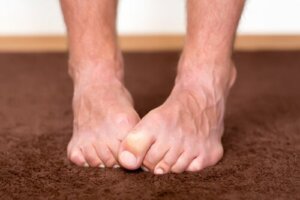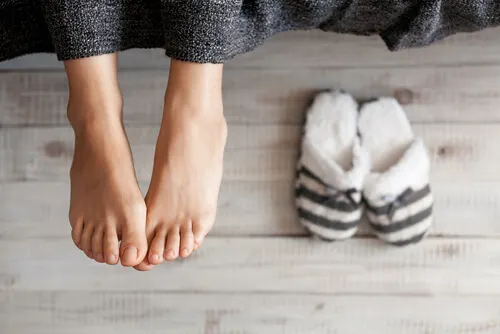Poor Circulation and Cold Feet


Written and verified by the doctor Leonardo Biolatto
Cold feet are a nuisance that we don’t usually pay too much attention to, as it usually occurs only sporadically. However, when it occurs frequently, it’s worth consulting a doctor, as it may be the result of poor circulation or other health problems. Find out all about poor circulation and cold feet in this article.
This condition is more common among women, and most of the time it won’t be too serious, especially if it occurs in cold seasons. If it occurs at any time of the year, and is accompanied by other symptoms, there’s a likelihood of it being poor circulation.
Poor circulation in the legs and cold feet are signs that are sometimes accompanied by tingling, numbness, and cramps. If this is your case, it’s best to consult a professional.
Poor circulation affects the feet
Keep in mind that our feet are far away from the heart and the blood has more difficulty reaching them. This means that they almost always have a lower temperature than the rest of the body.
If your foot temperature is persistently and habitually low, this could be due to poor circulation. In these cases, the distance from the heart isn’t the only factor, but there tends to be a problem that is hindering blood flow to that area.

Continue reading: Why Do We Get Cold Hands and Feet?
Common causes of poor circulation and cold feet
Peripheral artery disease
With this condition, there’s plaque buildup, and a narrowing and hardening of the arteries. Blood flow to the feet and legs is reduced, making the skin look pale. Sometimes there’s pain, tingling, and muscle problems similar to cramps.
Some people are at greater risk of developing this disease, particularly those who have hypertension, high blood cholesterol levels or are smokers. If all these risk factors combine, the danger is high.
Raynaud’s disease
Raynaud’s disease is a disorder of the blood vessels that affects the fingers and toes. In cold or stressful conditions, the vessels constrict and hinder blood flow. The episodes last from 10 minutes to more than an hour.
It’s common for the skin on the fingers to turn white or bluish, and a feeling of numbness is experienced. When circulation is restored, the skin turns red, and tingling, pain, and throbbing are experienced.
Other causes of cold feet
Poor circulation isn’t the only factor that causes cold feet. Sometimes there could be peripheral neuropathy, which is a common neurological disorder in diabetics. In this case, the feet feel cold from the patient’s perspective, but are warm to the touch.
Peripheral neuropathy also occurs in people who have vitamin B deficiency, injuries where there’s a compressed nerve, heavy metal poisoning, problematic alcohol consumption, or autoimmune disorders. It’s also associated with burning feet, with no apparent explanation.
Diabetic neuropathy may be the first reason for consultation among people who are unaware that they have diabetes.
Find out more: Diabetes and High Blood Pressure: What Can You Eat?
Signs of poor circulation
Symptoms appear long after poor circulation is already present, and that’s a problem. The first signs have to do with excessive tiredness in the feet, pins and needles, and pain. Other associated signs are as follows:
- Spider veins, which appear due to poor blood return and have the shape of a spider’s web.
- Varicose veins: a widening of the veins.
- Tingling and cramping when fatty deposits block the flow. It’s a risky long-term condition.
- Toenail changes with noticeable thickening and a change in coloration to bluish or purplish.
- Changes in the skin of the feet and legs. If brown spots appear, a specialist should be consulted as soon as possible.
Watch out for poor circulation!
Having very dry skin, slow healing of wounds on the lower limbs, or frequent cramping after moving a few feet, are all warning signs that warrant specialized consultation. Cold feet can be something unimportant, but we must always be attentive, so that we don’t miss a more serious pathology that we may have without realizing it.
All cited sources were thoroughly reviewed by our team to ensure their quality, reliability, currency, and validity. The bibliography of this article was considered reliable and of academic or scientific accuracy.
- Campos, S. A. C. (2019). Si tienes diabetes, cuida tus pies. Aprendamos juntos. Atalaya Médica Turolense, (15), 99-133.
- García-Gómez, M., Cabezón-Villalba, G., de Ybarra-Falcón, C., López-Díaz, J., & San Román-Calvar, J. A. (2019). Importancia del estudio sistemático de las palpitaciones. Rev Esp Casos Clin Med Intern (RECCMI), 2, 67-69.
- Severac, D., Bura-Rivière, A., & Boccalon, H. (2007). Fisiología y exploración de la circulación arterial. EMC-Podología, 9(4), 1-22.
- Rodríguez Heredia, Dunia. “Intoxicación ocupacional por metales pesados.” MediSan 21.12 (2017): 3372-3385.
This text is provided for informational purposes only and does not replace consultation with a professional. If in doubt, consult your specialist.








